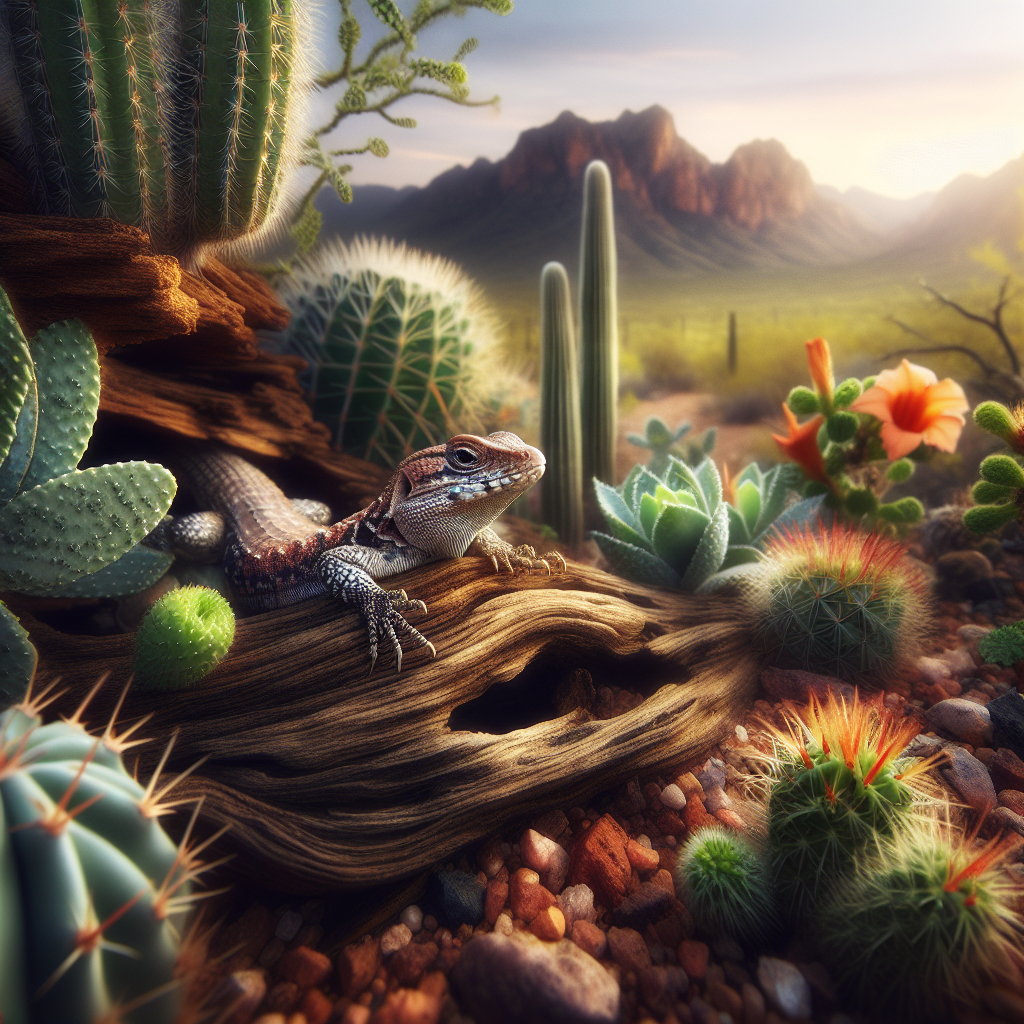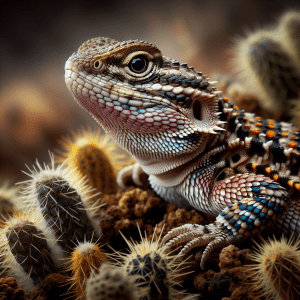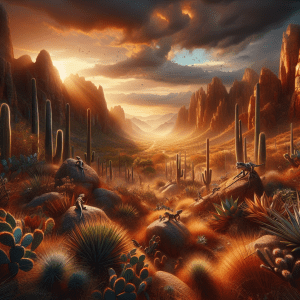Introduction to Sonoran Desert Lizards
The Sonoran Desert is a magical place, filled with an incredible array of unique creatures, including lizards that have adapted to thrive in this harsh environment. Imagine standing amidst the cacti and rocky terrain of the Sonoran Desert, with the scorching sun beating down on you, and suddenly, you spot a lizard scurrying across the sand. It’s a fascinating sight to behold, witnessing these resilient creatures in their natural habitat.
Sonoran Desert lizards are truly remarkable in their characteristics and adaptations. From their ability to blend seamlessly with their surroundings to their specialized skin that helps regulate body temperature, these lizards have evolved to perfection in this arid landscape. One interesting fact about Sonoran Desert lizards is their reliance on the environment for survival – their coloration, behavior, and even reproductive strategies are all intricately linked to the unique conditions of the desert.
As we delve deeper into the world of Sonoran Desert lizards, we begin to understand the importance of these creatures in the ecosystem. They play a vital role in controlling insect populations, serving as both predator and prey in the intricate web of desert life. Have you ever stopped to ponder the interconnectedness of all living beings in the desert and how each species, no matter how small, contributes to the balance of this fragile ecosystem?
The challenge of preserving the habitats of Sonoran Desert lizards is a pressing concern in today’s world. With increasing human encroachment and climate change threatening their survival, conservation efforts are more critical than ever. It’s a race against time to protect these unique species and ensure their continued existence for future generations to marvel at.
So, next time you find yourself in the Sonoran Desert, keep an eye out for these fascinating lizards and take a moment to appreciate the beauty and complexity of their ecology.
Characteristics and Adaptations of Sonoran Desert Lizards
Have you ever stopped to marvel at the incredible adaptations of Sonoran Desert lizards? It’s truly fascinating how these little creatures have evolved to thrive in such a harsh environment. Let me share some cool insights with you.
Did you know that Sonoran Desert lizards have developed unique characteristics that help them survive in the arid desert climate? From their specialized skin that helps regulate body temperature to their ability to camouflage with the sandy terrain, these adaptations are nothing short of remarkable.
One interesting fact about Sonoran Desert lizards is their ability to change color based on their surroundings. It’s like they have their own built-in camouflage gear! This adaptation not only helps them blend in with the desert landscape but also serves as a defense mechanism against predators.
Now, picture this – you’re out hiking in the Sonoran Desert, and suddenly, you spot a Chuckwalla lizard basking in the sun. As you observe its behavior, you’ll notice how these lizards use their specialized adaptations to cope with the extreme heat and limited water sources in the desert.
Have you ever wondered how Sonoran Desert lizards manage to thrive in such a challenging environment? Their unique characteristics not only help them survive but also play a crucial role in maintaining the delicate balance of the desert ecosystem.
Next time you come across a Sonoran Desert lizard during your outdoor adventures, take a moment to appreciate the incredible adaptations that make these creatures so resilient. It’s truly a testament to the wonders of nature and the endless possibilities of evolution.
So, what’s your favorite adaptation of Sonoran Desert lizards? Share your thoughts and let’s dive deeper into the fascinating world of these remarkable creatures.
Habitat and Distribution of Sonoran Desert Lizards
Imagine a vast expanse of desert landscape, shimmering under the blazing sun, with unique creatures camouflaged among the sandy dunes and rocky outcrops. This is the habitat and distribution of Sonoran Desert lizards, a fascinating subject that sheds light on the adaptability and resilience of these reptiles in extreme environments.
As we delve into the habitat and distribution of Sonoran Desert lizards, one cannot help but marvel at how these creatures have evolved to thrive in such challenging conditions. From the iconic Gila monster to the agile collared lizard, each species has carved out its niche in this arid ecosystem. Personal anecdote or experience related to this topic could involve stumbling upon a colorful desert spiny lizard basking on a sun-warmed rock or observing the swift movements of a zebra-tailed lizard darting across the desert floor.
An interesting fact about the habitat and distribution of Sonoran Desert lizards is that they are known to exhibit microhabitat preferences within the desert landscape. Some species may prefer rocky areas for basking and seeking shelter, while others thrive in sandy terrain or among vegetation. This diversity in habitat selection reflects the adaptability of Sonoran Desert lizards to different ecological niches within their range.
Exploring the challenge or controversy surrounding the habitat and distribution of Sonoran Desert lizards may involve considering the impact of human activities such as urbanization, habitat destruction, and climate change on these reptiles’ populations. As their natural habitats face increasing pressures, conservation efforts play a crucial role in protecting these iconic desert dwellers and preserving their unique ecosystems.
In conclusion, understanding the habitat and distribution of Sonoran Desert lizards offers a window into the intricate web of life in one of the world’s most iconic desert regions. By appreciating the beauty and complexity of their natural habitats, we gain a deeper appreciation for the resilience and diversity of these remarkable reptiles.
Importance of Sonoran Desert Lizards in the Ecosystem
Imagine you’re walking through the Sonoran Desert, surrounded by the vast expanse of sandy landscapes and towering cacti. Suddenly, you spot a colorful lizard darting across the arid terrain. That little lizard plays a significant role in the delicate balance of the desert ecosystem – that’s what we’re diving into today.
Sonoran Desert lizards are not just fascinating creatures to observe; they are essential players in the desert’s intricate web of life. Picture this – these lizards are like the guardians of the desert, maintaining the ecosystem’s health in ways we might not even realize. Their presence influences everything from plant distribution to insect populations, showcasing their vital role in this harsh environment.
One interesting fact about Sonoran Desert lizards is that they are masters of adaptation. From their ability to blend seamlessly into their surroundings to their unique behaviors for conserving water in the scorching heat, these lizards have evolved remarkable strategies to thrive in this challenging habitat. It’s like they’ve unlocked the secrets to survival in one of the harshest environments on Earth.
Now, let’s ponder this: How would the Sonoran Desert ecosystem be impacted if these lizards were to disappear? Think about the ripple effect – the interconnectedness of all living things in this desert landscape. It’s a stark reminder of how every creature, no matter how small, plays a crucial role in maintaining the balance of nature.
As we explore the importance of Sonoran Desert lizards in the ecosystem, we uncover a deeper understanding of how these seemingly insignificant creatures are actually the unsung heroes of the desert. So, next time you catch a glimpse of a lizard scurrying by, take a moment to appreciate the role they play in keeping the Sonoran Desert thriving and vibrant.
Threats and Conservation Status of Sonoran Desert Lizards
Have you ever thought about the important role Sonoran Desert lizards play in their ecosystem? It’s fascinating to consider how these small creatures contribute to the balance of nature. Sonoran Desert lizards, with their unique characteristics and behaviors, are vital components of the delicate desert environment.
Sonoran Desert lizards are not just interesting to observe; they are essential for maintaining the ecosystem’s health. These reptiles help control insect populations, which is crucial in such a harsh environment where resources are limited. Imagine a desert without lizards – the insect population would likely explode, causing a ripple effect throughout the entire ecosystem.
One interesting fact about Sonoran Desert lizards is their ability to survive in extreme temperatures. These resilient creatures have evolved various adaptations to cope with the desert’s scorching heat and limited water sources. From their efficient water conservation mechanisms to their heat-resistant scales, Sonoran Desert lizards have truly mastered the art of survival in their harsh habitat.
Understanding the threats facing Sonoran Desert lizards is essential for their conservation. Habitat destruction, climate change, and human activities pose significant challenges to these reptiles. By learning about these threats, we can take steps to protect and preserve the delicate balance of the Sonoran Desert ecosystem for future generations.
Next time you encounter a Sonoran Desert lizard in the wild, take a moment to appreciate its importance in the ecosystem. Observing these fascinating creatures in their natural habitat can provide valuable insights into their behavior and interactions with the environment. Remember, every lizard you see contributes to the intricate web of life in the Sonoran Desert.
So, let’s continue to explore and learn about the ecology of Sonoran Desert lizards, appreciating their unique characteristics and the vital role they play in their desert home.
Behavior and Reproduction of Sonoran Desert Lizards
Imagine you’re out hiking in the Sonoran Desert, and suddenly, you spot a group of Sonoran Desert lizards engaging in a fascinating display of behavior. These little creatures may seem inconspicuous at first glance, but their behaviors and breeding habits are truly remarkable.
Sonoran Desert lizards are known for their unique behaviors and reproduction strategies. Did you know that some species of Sonoran Desert lizards perform intricate courtship rituals to attract mates? It’s like watching a tiny dance performance unfold right in front of your eyes! These behaviors are not just fascinating to observe but also play a crucial role in ensuring the survival of their species in the harsh desert environment.
Understanding the behavior and reproduction of Sonoran Desert lizards can provide valuable insights into their survival strategies and ecosystem dynamics. Observing how these lizards interact with each other, communicate, and reproduce can offer a glimpse into the intricate web of life in the desert.
Have you ever wondered how these lizards manage to find each other in the vast expanse of the desert? Or how they protect their offspring from predators? The world of Sonoran Desert lizards is full of mysteries waiting to be unraveled.
Next time you encounter a Sonoran Desert lizard during your desert adventure, take a moment to observe its behavior closely. You might witness a fascinating display of courtship, territorial defense, or parental care that will deepen your appreciation for these remarkable creatures. Their behaviors are not just random actions but finely tuned adaptations honed by evolution to thrive in one of the harshest environments on Earth.
So, keep your eyes peeled for these tiny desert dwellers, and you might just witness a captivating glimpse into the secret lives of Sonoran Desert lizards.
Interactions with Other Species in the Sonoran Desert
As we dive into the topic of interactions between Sonoran Desert lizards and other species in their habitat, it’s truly fascinating to witness the intricate web of relationships that exist in this unique ecosystem. Picture this – a desert landscape teeming with life, where lizards play a crucial role in maintaining the delicate balance of nature.
One interesting fact to consider is that Sonoran Desert lizards often have complex interactions with various species, including predators, prey, competitors, and even mutualistic partners. For instance, the relationship between lizards and birds of prey showcases a classic predator-prey dynamic. Birds such as hawks and eagles hunt lizards for food, creating a natural cycle of life and death in the desert.
Additionally, some lizards engage in symbiotic relationships with other species. Take the case of certain lizard species that act as pollinators for desert plants by transferring pollen from one flower to another as they forage for nectar. This mutualistic interaction benefits both the lizards and the plants, highlighting the interconnectedness of life in the Sonoran Desert.
Exploring these interactions not only unveils the intricacies of desert ecosystems but also prompts us to ponder the broader implications of biodiversity and conservation. How do these relationships shape the overall health of the ecosystem? What can we learn from these interactions to better protect and preserve the diverse species that call the Sonoran Desert home?
By delving into the world of Sonoran Desert lizards and their interactions with other species, we gain a deeper appreciation for the interconnectedness of life in this arid environment. So, next time you spot a lizard darting across the desert landscape, remember that it’s not just a solitary creature but a vital player in a larger ecological drama unfolding in the Sonoran Desert.
Diet and Feeding Habits of Sonoran Desert Lizards
Lizards in the Sonoran Desert have quite the diverse palate when it comes to their diet. Did you know that these fascinating creatures are primarily insectivores, but some species also consume plants or even other lizards? It’s like a buffet out there in the desert!
Imagine this: you’re out hiking in the Sonoran Desert, marveling at the unique flora and fauna around you when suddenly, you spot a lizard on a rock. You observe as it pounces on an unsuspecting insect with lightning speed. That’s the moment you realize the impressive hunting skills these lizards possess.
Now, here’s a fun fact for you: while most Sonoran Desert lizards feed on insects such as beetles, ants, and grasshoppers, some species like the Collared Lizard are known to eat fruits and plants. It’s like they have their own version of a vegetarian diet in the desert!
Understanding the diet and feeding habits of Sonoran Desert lizards not only sheds light on their survival strategies but also highlights their essential role in the ecosystem. By feeding on insects, these lizards help control pest populations, contributing to the delicate balance of the desert ecosystem.
Next time you’re in the Sonoran Desert, keep an eye out for these incredible lizards and observe their feeding behaviors. It’s a fascinating sight to witness how they adapt to their environment and thrive by making the most of the resources available to them. Who knew that such tiny creatures could have such a big impact on their surroundings?
So, whether you’re a nature enthusiast or simply intrigued by the wonders of the desert, take a moment to appreciate the diverse diet of Sonoran Desert lizards and how it shapes their unique ecology.
Research and Studies on Sonoran Desert Lizards Ecology
I recently came across some fascinating information about the research and studies conducted on the ecology of Sonoran Desert lizards, and I couldn’t wait to share it with you. Scientists have delved deep into understanding these unique reptiles, uncovering some remarkable insights that shed light on their behavior and interactions within their environment.
One interesting fact that caught my attention is that researchers have discovered a wide range of lizard species in the Sonoran Desert, each with its own distinct ecological niche. From the iconic Gila Monster to the agile Collared Lizard, these reptiles play a crucial role in maintaining the delicate balance of the desert ecosystem. The diversity of lizards in this region has sparked numerous research endeavors aimed at unraveling the mysteries of their ecology.
One of the challenges faced by researchers studying Sonoran Desert lizards is the vast and rugged terrain of the desert itself. Trekking through the hot and arid landscape in search of these elusive creatures requires patience, perseverance, and a keen eye for detail. Despite the challenges, scientists have made significant strides in understanding the complex relationships between Sonoran Desert lizards and their environment.
As we delve deeper into the world of Sonoran Desert lizards, it makes me wonder about the broader implications of their ecology. How do changes in the desert climate impact these reptiles? What can we learn from studying their behavior and adaptations? These questions not only pique our curiosity but also highlight the interconnectedness of all living organisms in the natural world.
In conclusion, the research and studies on Sonoran Desert lizards’ ecology offer a fascinating glimpse into the intricate web of life in this unique ecosystem. By continuing to explore and study these reptiles, we can gain valuable insights that contribute to our understanding of biodiversity and conservation efforts in the Sonoran Desert and beyond.
Tips for Observing Sonoran Desert Lizards in the Wild
Oh, let me tell you about the fascinating world of Sonoran Desert lizards! These little creatures are truly remarkable. Did you know that some Sonoran Desert lizards have the ability to change color to blend in with their surroundings? It’s like having a built-in camouflage suit!
One interesting fact about Sonoran Desert lizards is that they have developed unique adaptations to survive in the harsh desert environment. From their specialized skin that helps them retain moisture to their clever burrowing techniques, these lizards are true masters of survival.
I remember one time when I was hiking in the Sonoran Desert, and I stumbled upon a beautiful Sonoran Desert spiny lizard basking in the sun. It was a magical moment to witness this creature in its natural habitat, perfectly adapted to thrive in the arid desert landscape.
Now, when it comes to observing Sonoran Desert lizards in the wild, there are a few tips to keep in mind. It’s essential to approach them quietly and slowly, as sudden movements can startle them. Remember to respect their space and avoid disrupting their natural behaviors.
Have you ever wondered about the role that Sonoran Desert lizards play in the ecosystem? These creatures are essential for maintaining the balance of the desert ecosystem by controlling insect populations and serving as a food source for predators.
As we delve into the ecology of Sonoran Desert lizards, it becomes clear that these creatures are not just fascinating to observe but also crucial for the health of their habitat. By learning more about these lizards and their interactions with the environment, we gain a deeper appreciation for the intricate web of life in the Sonoran Desert.




